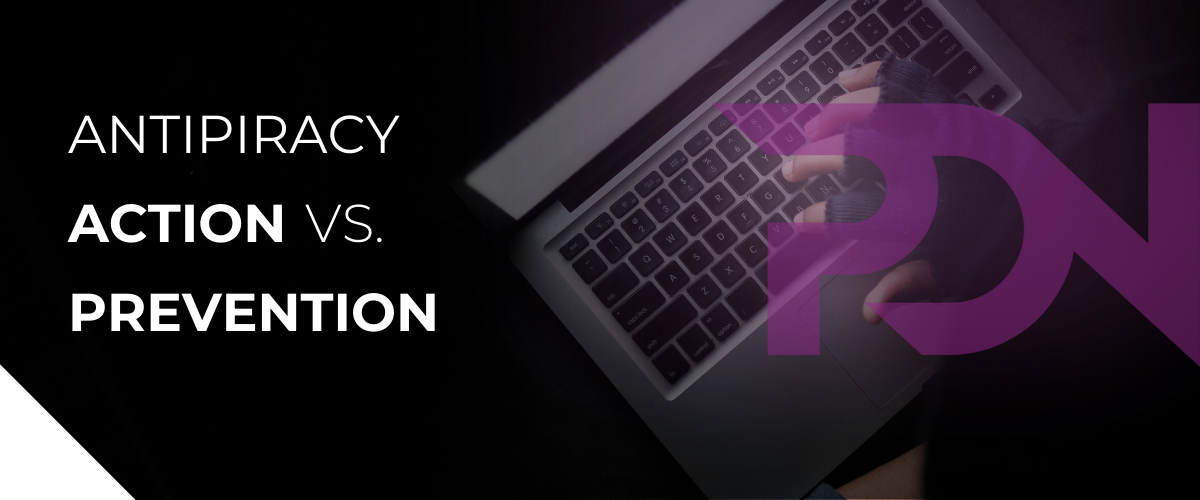
There are two ways to fight against the illegal use of your movies, TV shows, video games or ebooks: prevention or what we can call active methods. Let’s try to look at these two cybersecurity methods and see which one seems more effective.
“Technical” methods are widely used in the video game industry, and are designed to prevent the console or PC from launching the game does not come from an original source.
These methods also exist for ebooks (often DRMs) or films and Tv shows – in the movie industry, watermarking is probably the most commonly used.
This idea that technical barriers can prevent piracy has been around for a very long time; as early as 1985 Nintendo created a system for its first console—the NES—which allowed the game to be played only if the cartridges used had the company’s logo. Over the years, the video game industry has gone through activation keys, game alterations DRMs, watermarks, or the “always online” system launched by Diablo 3 and popularized by Steam, which became the standard for almost all contemporary games.

It seems now that the most promising method is the blockchain technology. Besides its other well-known applications in cryptocurrency, the blockchain technology allows a very reliable authentication method which could therefore allow a person to be associated with a specific copy of the game, thus avoiding piracy.
One of the main criticisms is that whatever technique is used, hackers have always found a way to circumvent them—many even see them as a challenge. They try to bypass them as quickly as possible, for fun or profit. DRM methods have also been accused of slowing down games and causing technical difficulties and performance drops even for players with legal versions, as shown several articles about the (both anti-piracy and anti-cheating) software Denuvo.
Preventive methods, however, if they do not eliminate piracy at the source, allow a better tracing of the illegal activity, which should facilitate the removal of illegal copies of your work. In addition, these methods can also prevent an out-of-control diffusion of pirate links containing malwares. Watermarking seems to be particularly effective in this respect.

What to do once the preventive methods failed and one or more copies of your movie, tv show, ebook or video game are online?
The first thing to do is to actually find the pirate files online. This means scanning all search engines with relevant keywords and separating fake pirate links (scams) from real copies of your product. A Google search is not enough to find all the links—many pirates have now turned to Russian search engines, which are less censored.
The search itself is not enough – you will have to scan dedicated sites and discussion forums—not everything that is relevant can be found with a basic search.
Of course, every file must be checked—many so-called DMCA farms send thousands of requests per day without any verification at all, removing your perfectly legal files and promotional tools, making your product less visible and causing you to lose revenue.
The next step is to send a request to Google – search results linking to pirate sites containing an illegal version of your product will be removed.
But this only removes the search results (and only on Google)—you still need to contact the hosts of the sites for every illegal copy and scan other search engines, less used by the general public, but well-known for piracy, like Yandex. To do this, you need to identify the host (the pirate site itself will never remove your content, despite the fact that some claim to do so)—which means you need to find out whom to send the removal request in order to make it effective, and then do the follow-up if your first attempt proves ineffective.
You will have to continue monitoring to see which files have been removed, and which are still waiting to be processed. And once all the process is over… you’ll have to repeat it.
If this sounds long and tedious, that’s because without experience in cybersecurity, and without the proper tools—coupled with human verification—it actually is.
However, if all this process is consistently implemented over several weeks or months (depending on the extent of the problem) removing the search links and content at the source, directly from the host, is still the most effective method.
Of course, as in any industry, one of the most effective “tools” against piracy is to offer a good product, with a large availability, at a good price.
The truth is that no method can suppress piracy altogether.
Unfortunately, it is still very easy to find copies of the latest video games, ebooks, movies and TV show online, even when there are no search results pointing towards them. Preventive methods, even the most efficient ones, do not prevent products from ending up on illegal download sites—they just make piracy slightly more difficult – but not for the general public, only for the people making the content available for free. Therefore, it is imperative to supplement them with a thorough and daily search for illegal copies of your product, and sending takedown requests.
Does the task seem long and complicated? Do not hesitate to contact our team of experts. We have more than 10 years of experience in antipiracy, and we have developed state of the art cyber security tools to optimize searches.
With our double-checking involving humans at every stage, we ensure that none of your legal links are removed by mistake, and our removal rate is close to 97%.
Stay with us for our next article on the film industry and discover the impressive effects of piracy.
© 2023 PDN Cyber Security Consultant. All rights reserved.